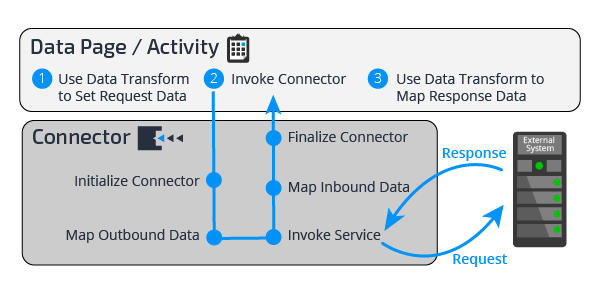
Connectors
Connectors
Imagine the process of applying for a loan. First, a customer completes a loan application and submits the application to the bank. The bank enters the customer’s information into the application system. The bank then verifies the customer's credit score with a credit agency. The bank application must integrate with the credit agency system to verify the credit score.
In this example, the application requests data from another system. Pega uses Connectors to facilitate this type of integration. Connectors are protocol specific, and they establish the link to the external system. Connectors implement the interface of the service running on the external system. Connectors also map the data structure of the application to the data structure used by the service called. You can parse, convert, and map data in either direction to or from the clipboard. For example, you can map data to and from XML, fixed record structure, or a record structure separated by a delimiter character.
You can invoke Connectors from data pages and activities. Use data pages to read, or pull, data from the external system. Use activities to write or push data to the external system.
How connectors exchange data
The invocation of a connector involves five components:
- Data page or activity – Specifies the connector to use and data transforms for request and response mapping
- Data transforms – Maps the data structure of your application to the integration clipboard pages, which correspond to the format expected by the service
- Connector rule – Uses the integration clipboard pages to build the request according to the protocol and service definition, invokes the service, and parses and places the response on the integration clipboard pages
- Mapping rules – For most connectors, mapping rules are used to build outgoing and parsing incoming messages
- External system – Exposes the service called
The following steps execute connector invocation occurs:
- The data page or activity executes a data transform to map the data from your application to the integration clipboard pages.
- The data page or activity invokes the connector:
- The connector is initialized based on its type. The type is the protocol the connector supports.
- The connector maps the request data to the protocol-specific format using the mapping rules specified for the connector. Do not confuse this mapping with data transforms. This mapping is between the clipboard and the format required by the protocol.
- The application sends the request to the external system.
-
The application receives the protocol-specific response. The response data is parsed using the mapping rules specified in the connector rule and placed on the integration clipboard pages.
- The connector is finalized and returns control to the data page or activity.
- Finally, a data transform maps the response data from the integration clipboard data structure to your application.
Supported connectors
Pega provides connectors for a wide range of industry-standard protocols and standards. Standard connectors include SOAP, REST, SAP, EJB, JMS, MQ, File, and CMIS.
